Analyzing Social Work Practices with Children, Young People, Families
VerifiedAdded on 2023/06/11
|9
|2525
|287
Essay
AI Summary
This essay explores social work practices concerning children, young people, and families, emphasizing the role of social work in promoting human growth, health, and social functioning. It delves into the application of theories such as the life course theory and the human ecology theory to understand individual and family well-being. The essay analyzes the Askin’s Family case study, examining how social changes and family dynamics, such as parental divorce, impact a child's behavior and mental health. It highlights the importance of family relationships, mental health habits, and open communication within families to address challenges and promote children's well-being. The discussion also covers the influence of microsystems, mesosystems, and ecosystems on a child's development, underscoring the interconnectedness of individual, family, and community environments. Desklib provides more solved assignments and study material for students.
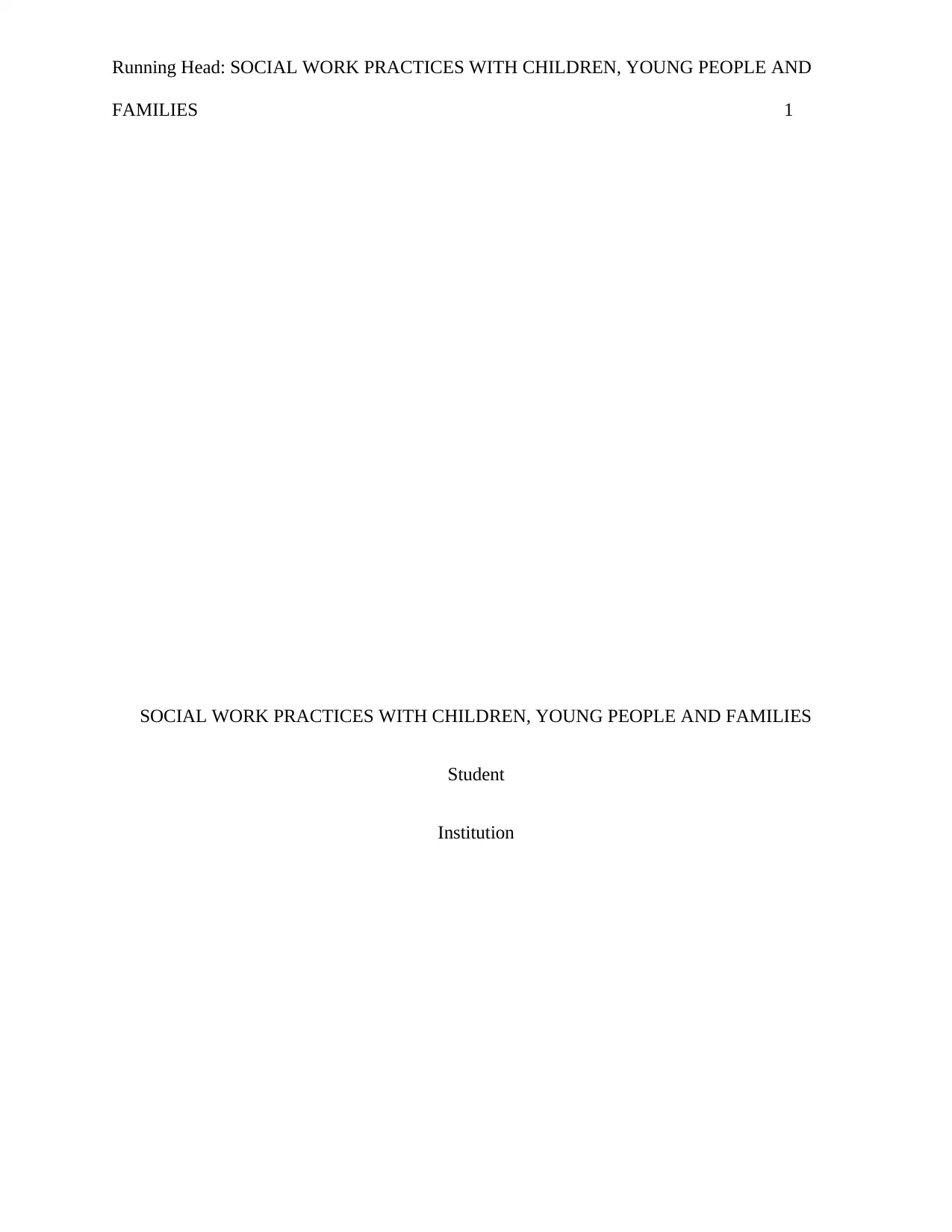
Running Head: SOCIAL WORK PRACTICES WITH CHILDREN, YOUNG PEOPLE AND
FAMILIES 1
SOCIAL WORK PRACTICES WITH CHILDREN, YOUNG PEOPLE AND FAMILIES
Student
Institution
FAMILIES 1
SOCIAL WORK PRACTICES WITH CHILDREN, YOUNG PEOPLE AND FAMILIES
Student
Institution
Paraphrase This Document
Need a fresh take? Get an instant paraphrase of this document with our AI Paraphraser
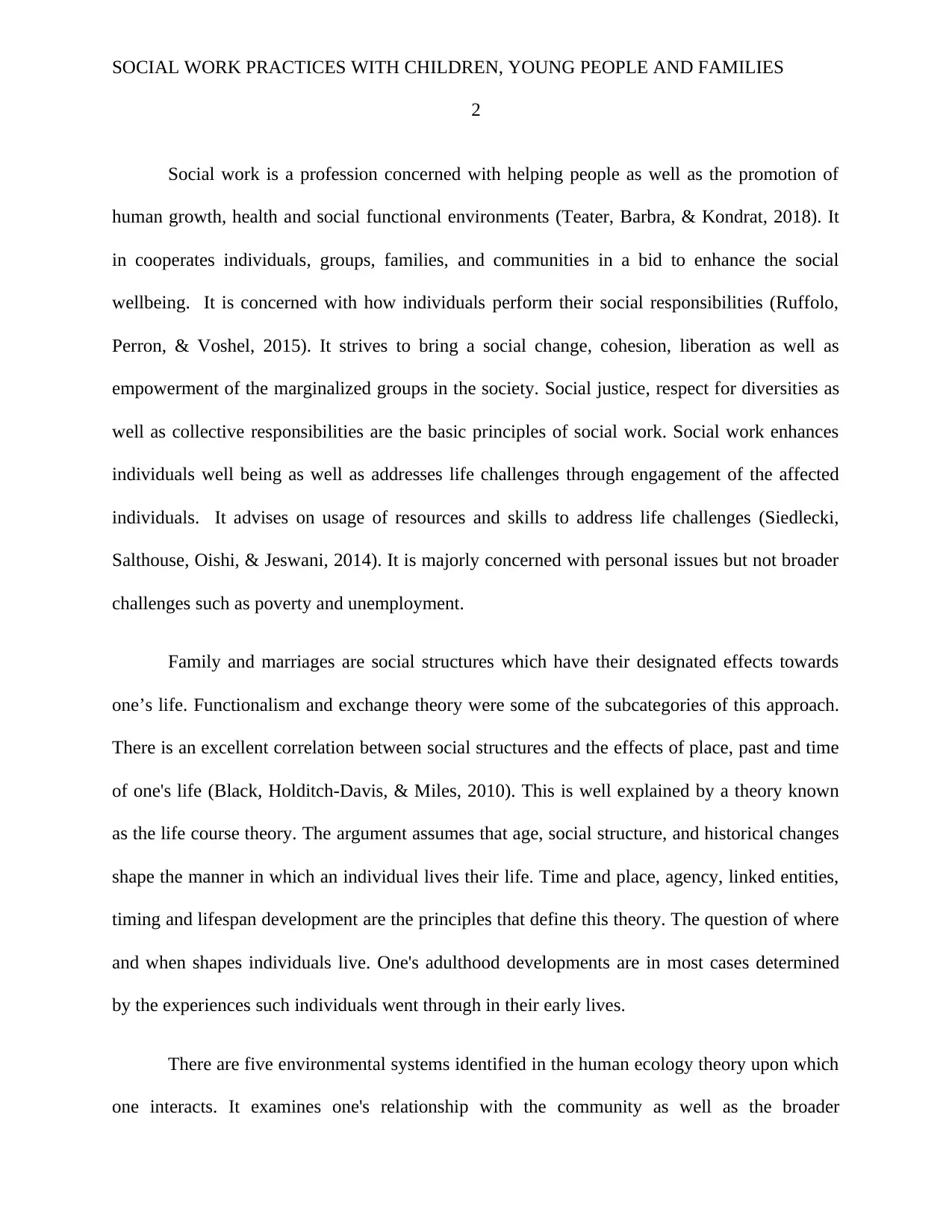
SOCIAL WORK PRACTICES WITH CHILDREN, YOUNG PEOPLE AND FAMILIES
2
Social work is a profession concerned with helping people as well as the promotion of
human growth, health and social functional environments (Teater, Barbra, & Kondrat, 2018). It
in cooperates individuals, groups, families, and communities in a bid to enhance the social
wellbeing. It is concerned with how individuals perform their social responsibilities (Ruffolo,
Perron, & Voshel, 2015). It strives to bring a social change, cohesion, liberation as well as
empowerment of the marginalized groups in the society. Social justice, respect for diversities as
well as collective responsibilities are the basic principles of social work. Social work enhances
individuals well being as well as addresses life challenges through engagement of the affected
individuals. It advises on usage of resources and skills to address life challenges (Siedlecki,
Salthouse, Oishi, & Jeswani, 2014). It is majorly concerned with personal issues but not broader
challenges such as poverty and unemployment.
Family and marriages are social structures which have their designated effects towards
one’s life. Functionalism and exchange theory were some of the subcategories of this approach.
There is an excellent correlation between social structures and the effects of place, past and time
of one's life (Black, Holditch-Davis, & Miles, 2010). This is well explained by a theory known
as the life course theory. The argument assumes that age, social structure, and historical changes
shape the manner in which an individual lives their life. Time and place, agency, linked entities,
timing and lifespan development are the principles that define this theory. The question of where
and when shapes individuals live. One's adulthood developments are in most cases determined
by the experiences such individuals went through in their early lives.
There are five environmental systems identified in the human ecology theory upon which
one interacts. It examines one's relationship with the community as well as the broader
2
Social work is a profession concerned with helping people as well as the promotion of
human growth, health and social functional environments (Teater, Barbra, & Kondrat, 2018). It
in cooperates individuals, groups, families, and communities in a bid to enhance the social
wellbeing. It is concerned with how individuals perform their social responsibilities (Ruffolo,
Perron, & Voshel, 2015). It strives to bring a social change, cohesion, liberation as well as
empowerment of the marginalized groups in the society. Social justice, respect for diversities as
well as collective responsibilities are the basic principles of social work. Social work enhances
individuals well being as well as addresses life challenges through engagement of the affected
individuals. It advises on usage of resources and skills to address life challenges (Siedlecki,
Salthouse, Oishi, & Jeswani, 2014). It is majorly concerned with personal issues but not broader
challenges such as poverty and unemployment.
Family and marriages are social structures which have their designated effects towards
one’s life. Functionalism and exchange theory were some of the subcategories of this approach.
There is an excellent correlation between social structures and the effects of place, past and time
of one's life (Black, Holditch-Davis, & Miles, 2010). This is well explained by a theory known
as the life course theory. The argument assumes that age, social structure, and historical changes
shape the manner in which an individual lives their life. Time and place, agency, linked entities,
timing and lifespan development are the principles that define this theory. The question of where
and when shapes individuals live. One's adulthood developments are in most cases determined
by the experiences such individuals went through in their early lives.
There are five environmental systems identified in the human ecology theory upon which
one interacts. It examines one's relationship with the community as well as the broader
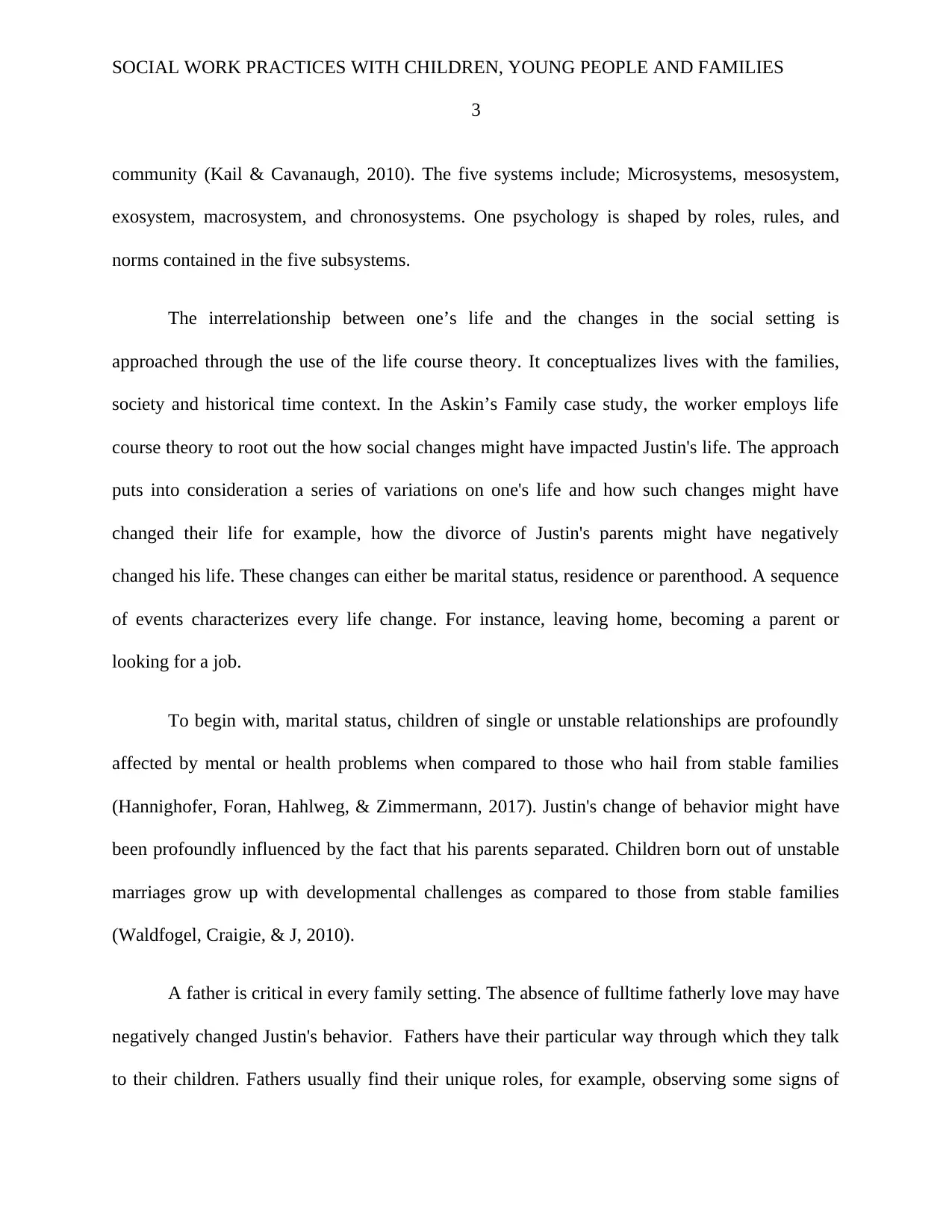
SOCIAL WORK PRACTICES WITH CHILDREN, YOUNG PEOPLE AND FAMILIES
3
community (Kail & Cavanaugh, 2010). The five systems include; Microsystems, mesosystem,
exosystem, macrosystem, and chronosystems. One psychology is shaped by roles, rules, and
norms contained in the five subsystems.
The interrelationship between one’s life and the changes in the social setting is
approached through the use of the life course theory. It conceptualizes lives with the families,
society and historical time context. In the Askin’s Family case study, the worker employs life
course theory to root out the how social changes might have impacted Justin's life. The approach
puts into consideration a series of variations on one's life and how such changes might have
changed their life for example, how the divorce of Justin's parents might have negatively
changed his life. These changes can either be marital status, residence or parenthood. A sequence
of events characterizes every life change. For instance, leaving home, becoming a parent or
looking for a job.
To begin with, marital status, children of single or unstable relationships are profoundly
affected by mental or health problems when compared to those who hail from stable families
(Hannighofer, Foran, Hahlweg, & Zimmermann, 2017). Justin's change of behavior might have
been profoundly influenced by the fact that his parents separated. Children born out of unstable
marriages grow up with developmental challenges as compared to those from stable families
(Waldfogel, Craigie, & J, 2010).
A father is critical in every family setting. The absence of fulltime fatherly love may have
negatively changed Justin's behavior. Fathers have their particular way through which they talk
to their children. Fathers usually find their unique roles, for example, observing some signs of
3
community (Kail & Cavanaugh, 2010). The five systems include; Microsystems, mesosystem,
exosystem, macrosystem, and chronosystems. One psychology is shaped by roles, rules, and
norms contained in the five subsystems.
The interrelationship between one’s life and the changes in the social setting is
approached through the use of the life course theory. It conceptualizes lives with the families,
society and historical time context. In the Askin’s Family case study, the worker employs life
course theory to root out the how social changes might have impacted Justin's life. The approach
puts into consideration a series of variations on one's life and how such changes might have
changed their life for example, how the divorce of Justin's parents might have negatively
changed his life. These changes can either be marital status, residence or parenthood. A sequence
of events characterizes every life change. For instance, leaving home, becoming a parent or
looking for a job.
To begin with, marital status, children of single or unstable relationships are profoundly
affected by mental or health problems when compared to those who hail from stable families
(Hannighofer, Foran, Hahlweg, & Zimmermann, 2017). Justin's change of behavior might have
been profoundly influenced by the fact that his parents separated. Children born out of unstable
marriages grow up with developmental challenges as compared to those from stable families
(Waldfogel, Craigie, & J, 2010).
A father is critical in every family setting. The absence of fulltime fatherly love may have
negatively changed Justin's behavior. Fathers have their particular way through which they talk
to their children. Fathers usually find their unique roles, for example, observing some signs of
⊘ This is a preview!⊘
Do you want full access?
Subscribe today to unlock all pages.

Trusted by 1+ million students worldwide
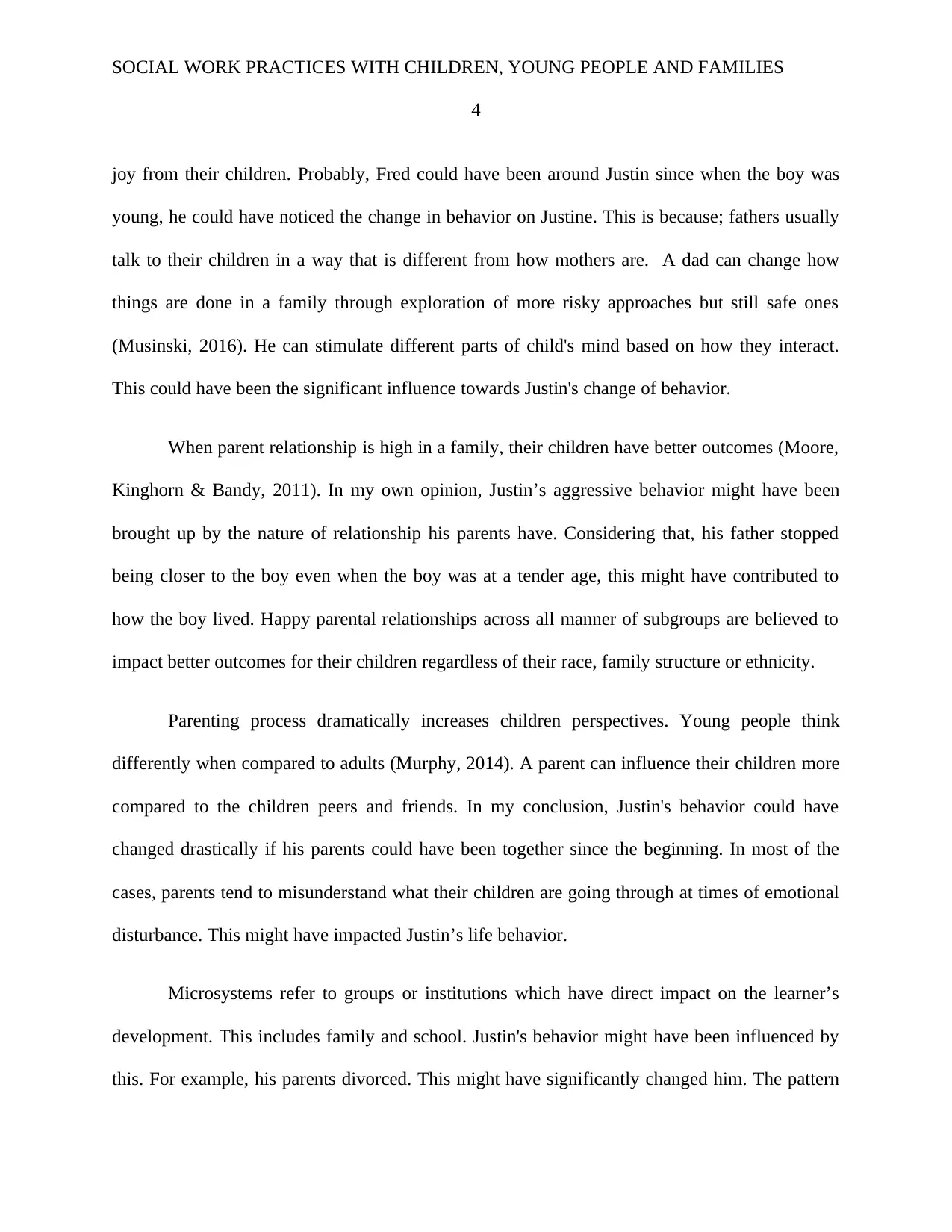
SOCIAL WORK PRACTICES WITH CHILDREN, YOUNG PEOPLE AND FAMILIES
4
joy from their children. Probably, Fred could have been around Justin since when the boy was
young, he could have noticed the change in behavior on Justine. This is because; fathers usually
talk to their children in a way that is different from how mothers are. A dad can change how
things are done in a family through exploration of more risky approaches but still safe ones
(Musinski, 2016). He can stimulate different parts of child's mind based on how they interact.
This could have been the significant influence towards Justin's change of behavior.
When parent relationship is high in a family, their children have better outcomes (Moore,
Kinghorn & Bandy, 2011). In my own opinion, Justin’s aggressive behavior might have been
brought up by the nature of relationship his parents have. Considering that, his father stopped
being closer to the boy even when the boy was at a tender age, this might have contributed to
how the boy lived. Happy parental relationships across all manner of subgroups are believed to
impact better outcomes for their children regardless of their race, family structure or ethnicity.
Parenting process dramatically increases children perspectives. Young people think
differently when compared to adults (Murphy, 2014). A parent can influence their children more
compared to the children peers and friends. In my conclusion, Justin's behavior could have
changed drastically if his parents could have been together since the beginning. In most of the
cases, parents tend to misunderstand what their children are going through at times of emotional
disturbance. This might have impacted Justin’s life behavior.
Microsystems refer to groups or institutions which have direct impact on the learner’s
development. This includes family and school. Justin's behavior might have been influenced by
this. For example, his parents divorced. This might have significantly changed him. The pattern
4
joy from their children. Probably, Fred could have been around Justin since when the boy was
young, he could have noticed the change in behavior on Justine. This is because; fathers usually
talk to their children in a way that is different from how mothers are. A dad can change how
things are done in a family through exploration of more risky approaches but still safe ones
(Musinski, 2016). He can stimulate different parts of child's mind based on how they interact.
This could have been the significant influence towards Justin's change of behavior.
When parent relationship is high in a family, their children have better outcomes (Moore,
Kinghorn & Bandy, 2011). In my own opinion, Justin’s aggressive behavior might have been
brought up by the nature of relationship his parents have. Considering that, his father stopped
being closer to the boy even when the boy was at a tender age, this might have contributed to
how the boy lived. Happy parental relationships across all manner of subgroups are believed to
impact better outcomes for their children regardless of their race, family structure or ethnicity.
Parenting process dramatically increases children perspectives. Young people think
differently when compared to adults (Murphy, 2014). A parent can influence their children more
compared to the children peers and friends. In my conclusion, Justin's behavior could have
changed drastically if his parents could have been together since the beginning. In most of the
cases, parents tend to misunderstand what their children are going through at times of emotional
disturbance. This might have impacted Justin’s life behavior.
Microsystems refer to groups or institutions which have direct impact on the learner’s
development. This includes family and school. Justin's behavior might have been influenced by
this. For example, his parents divorced. This might have significantly changed him. The pattern
Paraphrase This Document
Need a fresh take? Get an instant paraphrase of this document with our AI Paraphraser
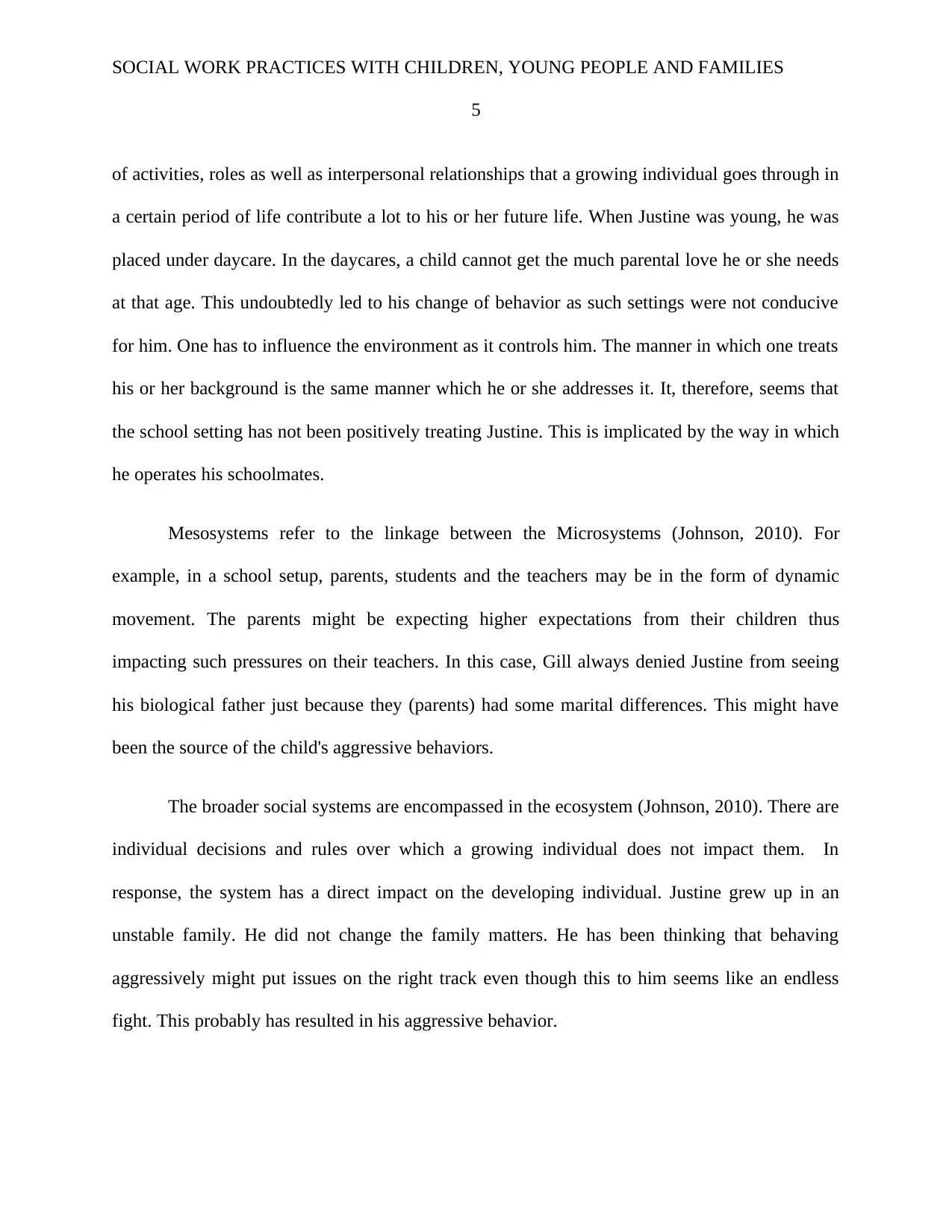
SOCIAL WORK PRACTICES WITH CHILDREN, YOUNG PEOPLE AND FAMILIES
5
of activities, roles as well as interpersonal relationships that a growing individual goes through in
a certain period of life contribute a lot to his or her future life. When Justine was young, he was
placed under daycare. In the daycares, a child cannot get the much parental love he or she needs
at that age. This undoubtedly led to his change of behavior as such settings were not conducive
for him. One has to influence the environment as it controls him. The manner in which one treats
his or her background is the same manner which he or she addresses it. It, therefore, seems that
the school setting has not been positively treating Justine. This is implicated by the way in which
he operates his schoolmates.
Mesosystems refer to the linkage between the Microsystems (Johnson, 2010). For
example, in a school setup, parents, students and the teachers may be in the form of dynamic
movement. The parents might be expecting higher expectations from their children thus
impacting such pressures on their teachers. In this case, Gill always denied Justine from seeing
his biological father just because they (parents) had some marital differences. This might have
been the source of the child's aggressive behaviors.
The broader social systems are encompassed in the ecosystem (Johnson, 2010). There are
individual decisions and rules over which a growing individual does not impact them. In
response, the system has a direct impact on the developing individual. Justine grew up in an
unstable family. He did not change the family matters. He has been thinking that behaving
aggressively might put issues on the right track even though this to him seems like an endless
fight. This probably has resulted in his aggressive behavior.
5
of activities, roles as well as interpersonal relationships that a growing individual goes through in
a certain period of life contribute a lot to his or her future life. When Justine was young, he was
placed under daycare. In the daycares, a child cannot get the much parental love he or she needs
at that age. This undoubtedly led to his change of behavior as such settings were not conducive
for him. One has to influence the environment as it controls him. The manner in which one treats
his or her background is the same manner which he or she addresses it. It, therefore, seems that
the school setting has not been positively treating Justine. This is implicated by the way in which
he operates his schoolmates.
Mesosystems refer to the linkage between the Microsystems (Johnson, 2010). For
example, in a school setup, parents, students and the teachers may be in the form of dynamic
movement. The parents might be expecting higher expectations from their children thus
impacting such pressures on their teachers. In this case, Gill always denied Justine from seeing
his biological father just because they (parents) had some marital differences. This might have
been the source of the child's aggressive behaviors.
The broader social systems are encompassed in the ecosystem (Johnson, 2010). There are
individual decisions and rules over which a growing individual does not impact them. In
response, the system has a direct impact on the developing individual. Justine grew up in an
unstable family. He did not change the family matters. He has been thinking that behaving
aggressively might put issues on the right track even though this to him seems like an endless
fight. This probably has resulted in his aggressive behavior.
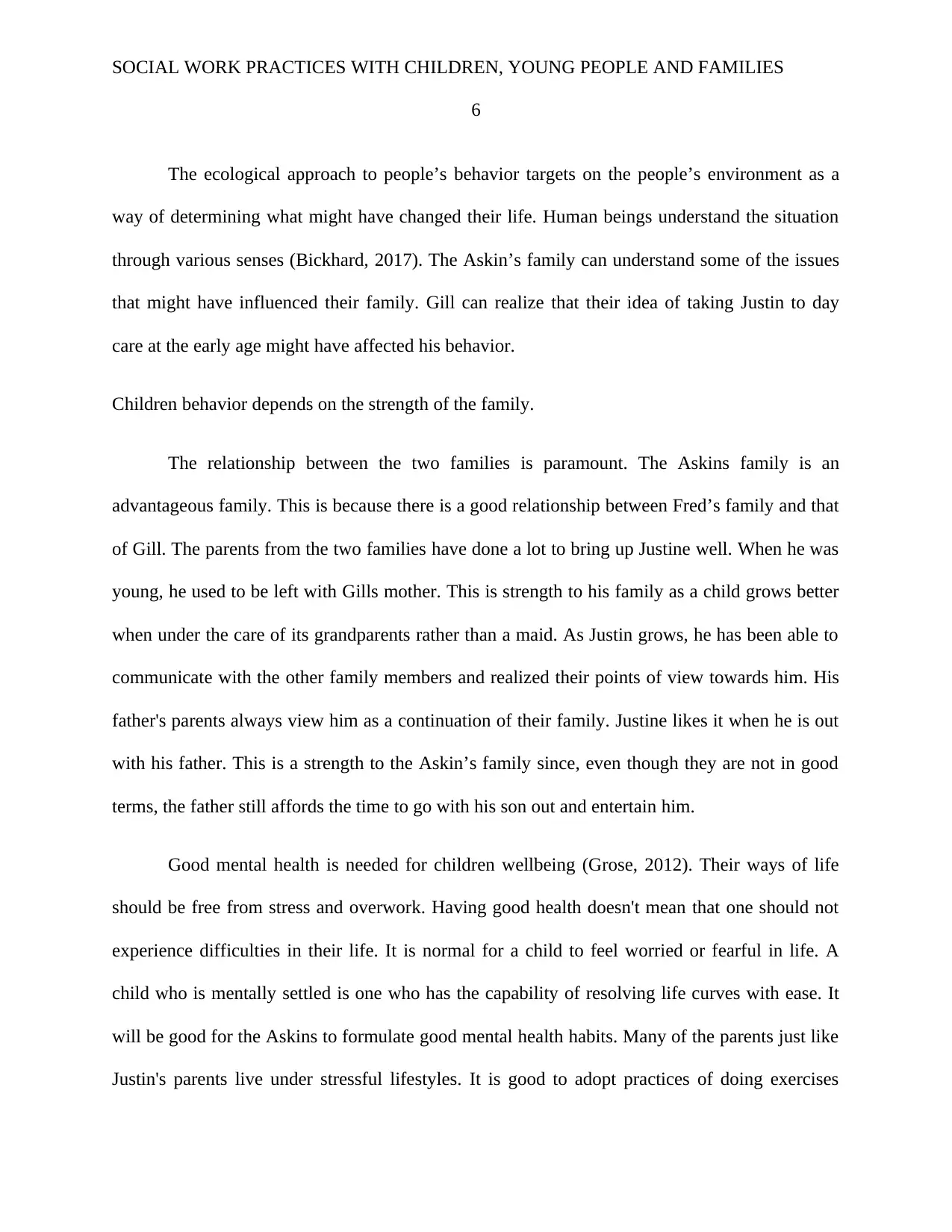
SOCIAL WORK PRACTICES WITH CHILDREN, YOUNG PEOPLE AND FAMILIES
6
The ecological approach to people’s behavior targets on the people’s environment as a
way of determining what might have changed their life. Human beings understand the situation
through various senses (Bickhard, 2017). The Askin’s family can understand some of the issues
that might have influenced their family. Gill can realize that their idea of taking Justin to day
care at the early age might have affected his behavior.
Children behavior depends on the strength of the family.
The relationship between the two families is paramount. The Askins family is an
advantageous family. This is because there is a good relationship between Fred’s family and that
of Gill. The parents from the two families have done a lot to bring up Justine well. When he was
young, he used to be left with Gills mother. This is strength to his family as a child grows better
when under the care of its grandparents rather than a maid. As Justin grows, he has been able to
communicate with the other family members and realized their points of view towards him. His
father's parents always view him as a continuation of their family. Justine likes it when he is out
with his father. This is a strength to the Askin’s family since, even though they are not in good
terms, the father still affords the time to go with his son out and entertain him.
Good mental health is needed for children wellbeing (Grose, 2012). Their ways of life
should be free from stress and overwork. Having good health doesn't mean that one should not
experience difficulties in their life. It is normal for a child to feel worried or fearful in life. A
child who is mentally settled is one who has the capability of resolving life curves with ease. It
will be good for the Askins to formulate good mental health habits. Many of the parents just like
Justin's parents live under stressful lifestyles. It is good to adopt practices of doing exercises
6
The ecological approach to people’s behavior targets on the people’s environment as a
way of determining what might have changed their life. Human beings understand the situation
through various senses (Bickhard, 2017). The Askin’s family can understand some of the issues
that might have influenced their family. Gill can realize that their idea of taking Justin to day
care at the early age might have affected his behavior.
Children behavior depends on the strength of the family.
The relationship between the two families is paramount. The Askins family is an
advantageous family. This is because there is a good relationship between Fred’s family and that
of Gill. The parents from the two families have done a lot to bring up Justine well. When he was
young, he used to be left with Gills mother. This is strength to his family as a child grows better
when under the care of its grandparents rather than a maid. As Justin grows, he has been able to
communicate with the other family members and realized their points of view towards him. His
father's parents always view him as a continuation of their family. Justine likes it when he is out
with his father. This is a strength to the Askin’s family since, even though they are not in good
terms, the father still affords the time to go with his son out and entertain him.
Good mental health is needed for children wellbeing (Grose, 2012). Their ways of life
should be free from stress and overwork. Having good health doesn't mean that one should not
experience difficulties in their life. It is normal for a child to feel worried or fearful in life. A
child who is mentally settled is one who has the capability of resolving life curves with ease. It
will be good for the Askins to formulate good mental health habits. Many of the parents just like
Justin's parents live under stressful lifestyles. It is good to adopt practices of doing exercises
⊘ This is a preview!⊘
Do you want full access?
Subscribe today to unlock all pages.

Trusted by 1+ million students worldwide
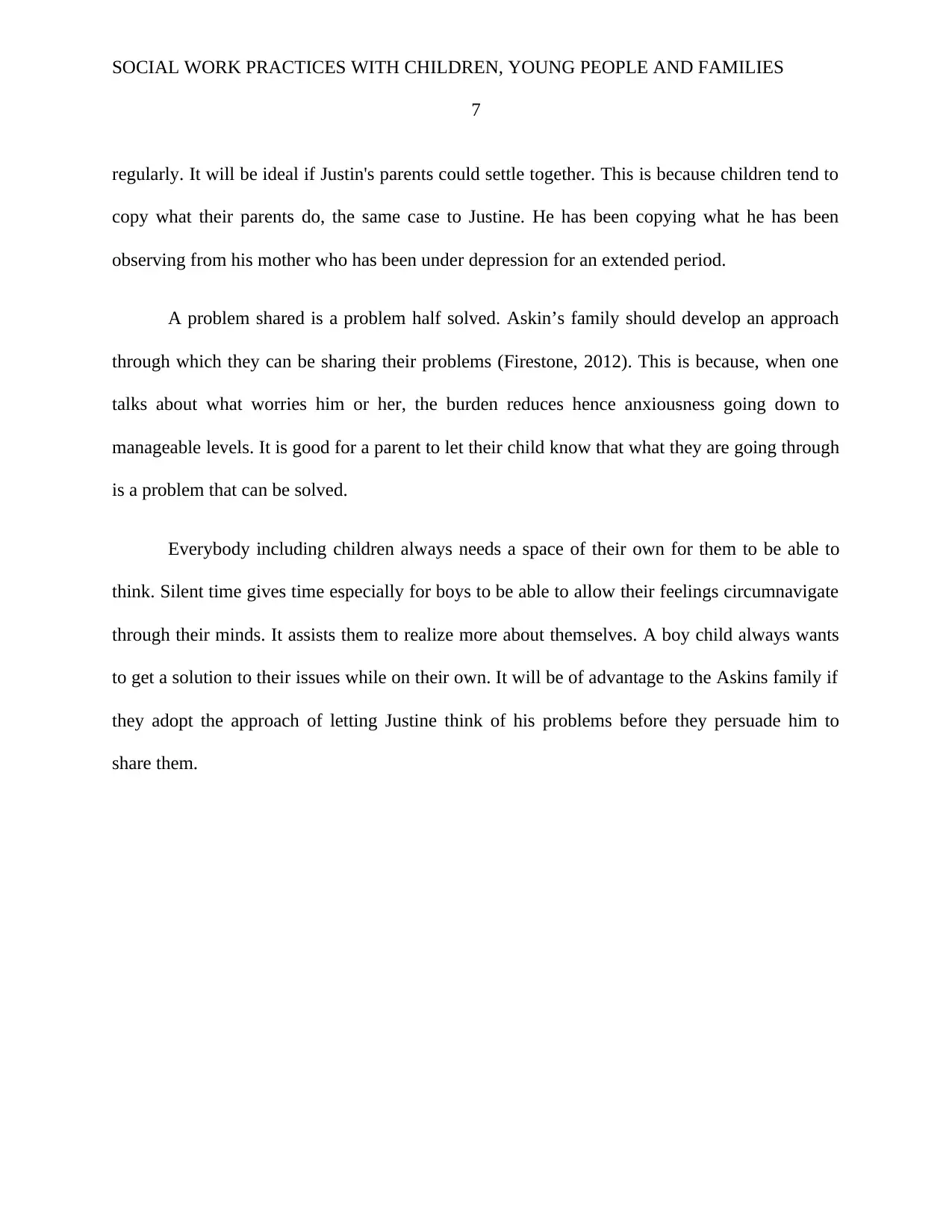
SOCIAL WORK PRACTICES WITH CHILDREN, YOUNG PEOPLE AND FAMILIES
7
regularly. It will be ideal if Justin's parents could settle together. This is because children tend to
copy what their parents do, the same case to Justine. He has been copying what he has been
observing from his mother who has been under depression for an extended period.
A problem shared is a problem half solved. Askin’s family should develop an approach
through which they can be sharing their problems (Firestone, 2012). This is because, when one
talks about what worries him or her, the burden reduces hence anxiousness going down to
manageable levels. It is good for a parent to let their child know that what they are going through
is a problem that can be solved.
Everybody including children always needs a space of their own for them to be able to
think. Silent time gives time especially for boys to be able to allow their feelings circumnavigate
through their minds. It assists them to realize more about themselves. A boy child always wants
to get a solution to their issues while on their own. It will be of advantage to the Askins family if
they adopt the approach of letting Justine think of his problems before they persuade him to
share them.
7
regularly. It will be ideal if Justin's parents could settle together. This is because children tend to
copy what their parents do, the same case to Justine. He has been copying what he has been
observing from his mother who has been under depression for an extended period.
A problem shared is a problem half solved. Askin’s family should develop an approach
through which they can be sharing their problems (Firestone, 2012). This is because, when one
talks about what worries him or her, the burden reduces hence anxiousness going down to
manageable levels. It is good for a parent to let their child know that what they are going through
is a problem that can be solved.
Everybody including children always needs a space of their own for them to be able to
think. Silent time gives time especially for boys to be able to allow their feelings circumnavigate
through their minds. It assists them to realize more about themselves. A boy child always wants
to get a solution to their issues while on their own. It will be of advantage to the Askins family if
they adopt the approach of letting Justine think of his problems before they persuade him to
share them.
Paraphrase This Document
Need a fresh take? Get an instant paraphrase of this document with our AI Paraphraser
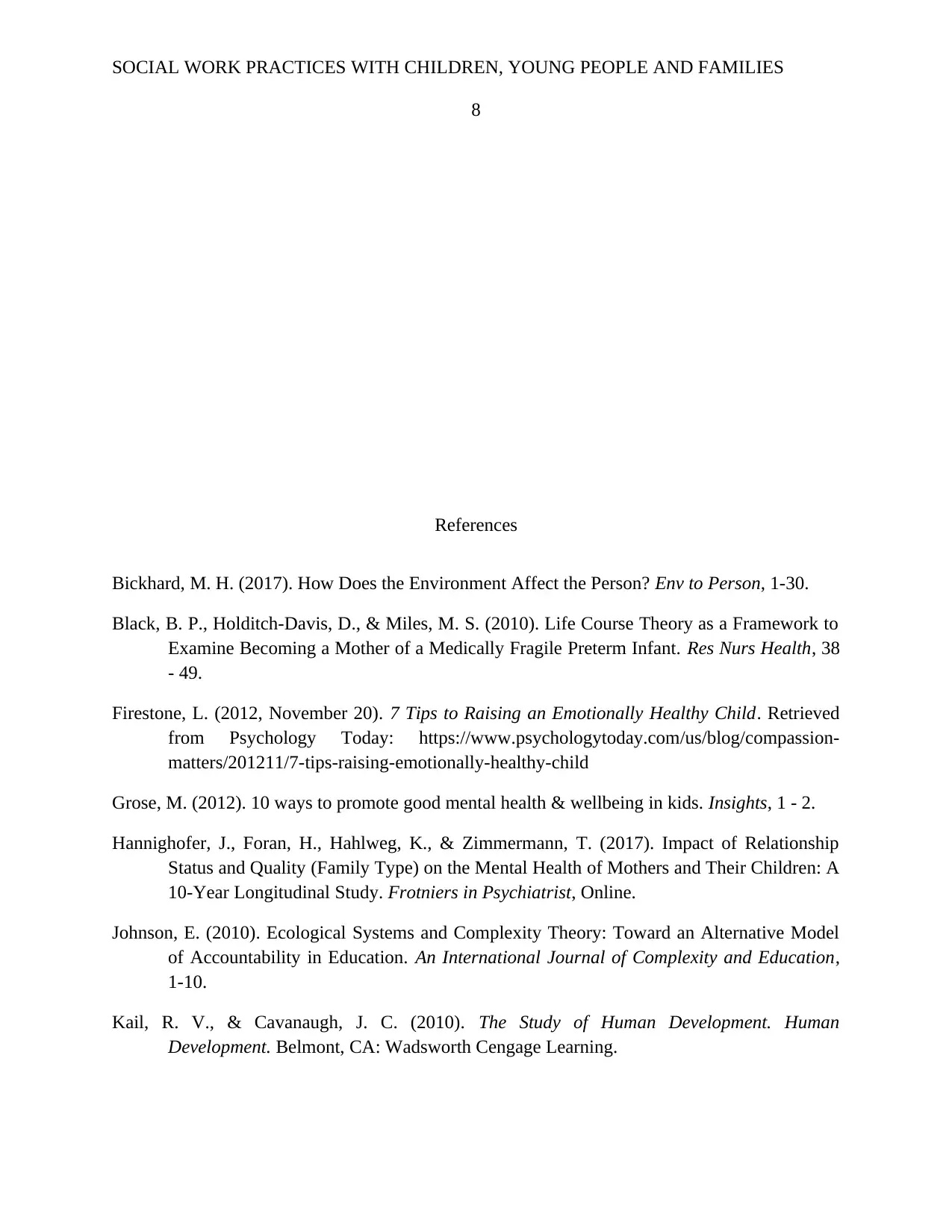
SOCIAL WORK PRACTICES WITH CHILDREN, YOUNG PEOPLE AND FAMILIES
8
References
Bickhard, M. H. (2017). How Does the Environment Affect the Person? Env to Person, 1-30.
Black, B. P., Holditch-Davis, D., & Miles, M. S. (2010). Life Course Theory as a Framework to
Examine Becoming a Mother of a Medically Fragile Preterm Infant. Res Nurs Health, 38
- 49.
Firestone, L. (2012, November 20). 7 Tips to Raising an Emotionally Healthy Child. Retrieved
from Psychology Today: https://www.psychologytoday.com/us/blog/compassion-
matters/201211/7-tips-raising-emotionally-healthy-child
Grose, M. (2012). 10 ways to promote good mental health & wellbeing in kids. Insights, 1 - 2.
Hannighofer, J., Foran, H., Hahlweg, K., & Zimmermann, T. (2017). Impact of Relationship
Status and Quality (Family Type) on the Mental Health of Mothers and Their Children: A
10-Year Longitudinal Study. Frotniers in Psychiatrist, Online.
Johnson, E. (2010). Ecological Systems and Complexity Theory: Toward an Alternative Model
of Accountability in Education. An International Journal of Complexity and Education,
1-10.
Kail, R. V., & Cavanaugh, J. C. (2010). The Study of Human Development. Human
Development. Belmont, CA: Wadsworth Cengage Learning.
8
References
Bickhard, M. H. (2017). How Does the Environment Affect the Person? Env to Person, 1-30.
Black, B. P., Holditch-Davis, D., & Miles, M. S. (2010). Life Course Theory as a Framework to
Examine Becoming a Mother of a Medically Fragile Preterm Infant. Res Nurs Health, 38
- 49.
Firestone, L. (2012, November 20). 7 Tips to Raising an Emotionally Healthy Child. Retrieved
from Psychology Today: https://www.psychologytoday.com/us/blog/compassion-
matters/201211/7-tips-raising-emotionally-healthy-child
Grose, M. (2012). 10 ways to promote good mental health & wellbeing in kids. Insights, 1 - 2.
Hannighofer, J., Foran, H., Hahlweg, K., & Zimmermann, T. (2017). Impact of Relationship
Status and Quality (Family Type) on the Mental Health of Mothers and Their Children: A
10-Year Longitudinal Study. Frotniers in Psychiatrist, Online.
Johnson, E. (2010). Ecological Systems and Complexity Theory: Toward an Alternative Model
of Accountability in Education. An International Journal of Complexity and Education,
1-10.
Kail, R. V., & Cavanaugh, J. C. (2010). The Study of Human Development. Human
Development. Belmont, CA: Wadsworth Cengage Learning.
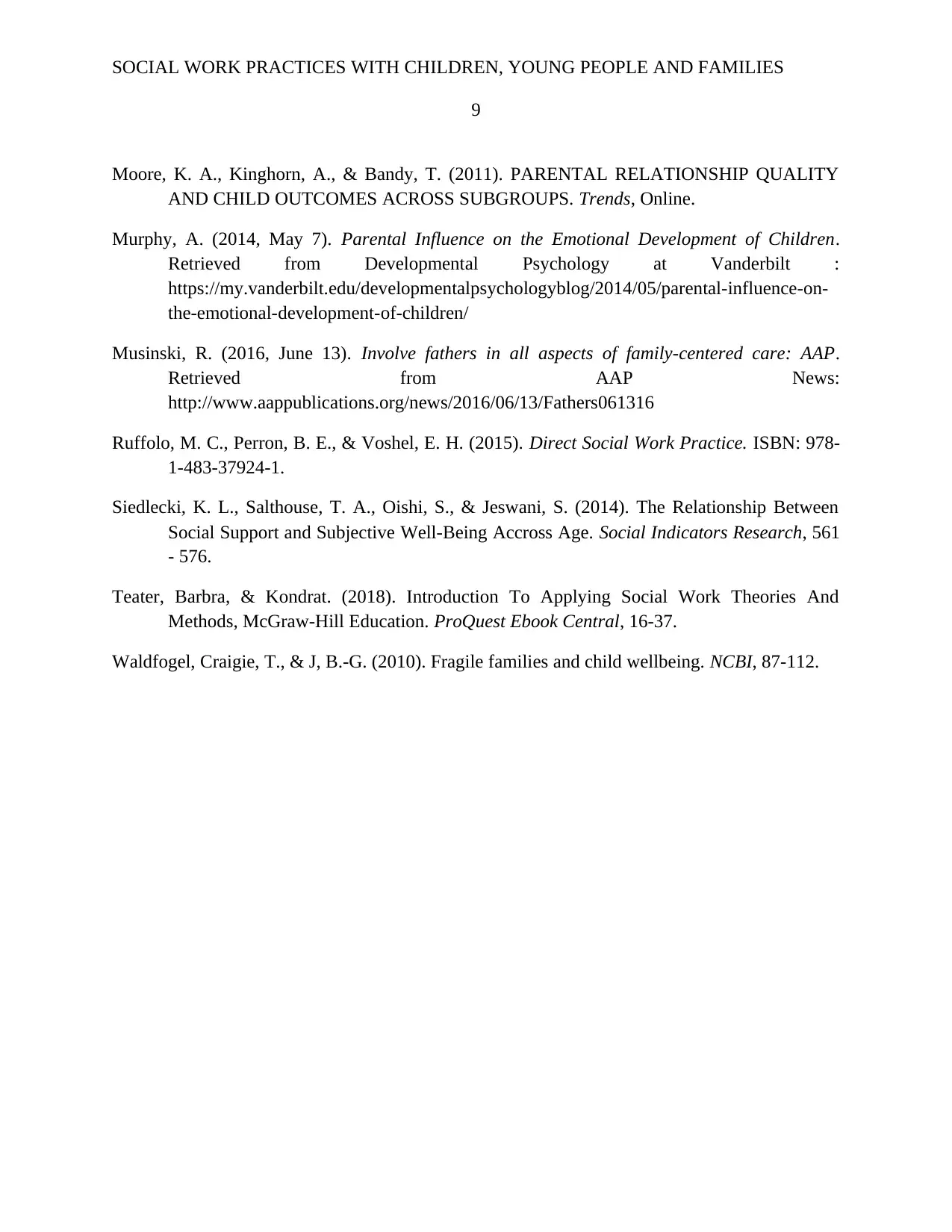
SOCIAL WORK PRACTICES WITH CHILDREN, YOUNG PEOPLE AND FAMILIES
9
Moore, K. A., Kinghorn, A., & Bandy, T. (2011). PARENTAL RELATIONSHIP QUALITY
AND CHILD OUTCOMES ACROSS SUBGROUPS. Trends, Online.
Murphy, A. (2014, May 7). Parental Influence on the Emotional Development of Children.
Retrieved from Developmental Psychology at Vanderbilt :
https://my.vanderbilt.edu/developmentalpsychologyblog/2014/05/parental-influence-on-
the-emotional-development-of-children/
Musinski, R. (2016, June 13). Involve fathers in all aspects of family-centered care: AAP.
Retrieved from AAP News:
http://www.aappublications.org/news/2016/06/13/Fathers061316
Ruffolo, M. C., Perron, B. E., & Voshel, E. H. (2015). Direct Social Work Practice. ISBN: 978-
1-483-37924-1.
Siedlecki, K. L., Salthouse, T. A., Oishi, S., & Jeswani, S. (2014). The Relationship Between
Social Support and Subjective Well-Being Accross Age. Social Indicators Research, 561
- 576.
Teater, Barbra, & Kondrat. (2018). Introduction To Applying Social Work Theories And
Methods, McGraw-Hill Education. ProQuest Ebook Central, 16-37.
Waldfogel, Craigie, T., & J, B.-G. (2010). Fragile families and child wellbeing. NCBI, 87-112.
9
Moore, K. A., Kinghorn, A., & Bandy, T. (2011). PARENTAL RELATIONSHIP QUALITY
AND CHILD OUTCOMES ACROSS SUBGROUPS. Trends, Online.
Murphy, A. (2014, May 7). Parental Influence on the Emotional Development of Children.
Retrieved from Developmental Psychology at Vanderbilt :
https://my.vanderbilt.edu/developmentalpsychologyblog/2014/05/parental-influence-on-
the-emotional-development-of-children/
Musinski, R. (2016, June 13). Involve fathers in all aspects of family-centered care: AAP.
Retrieved from AAP News:
http://www.aappublications.org/news/2016/06/13/Fathers061316
Ruffolo, M. C., Perron, B. E., & Voshel, E. H. (2015). Direct Social Work Practice. ISBN: 978-
1-483-37924-1.
Siedlecki, K. L., Salthouse, T. A., Oishi, S., & Jeswani, S. (2014). The Relationship Between
Social Support and Subjective Well-Being Accross Age. Social Indicators Research, 561
- 576.
Teater, Barbra, & Kondrat. (2018). Introduction To Applying Social Work Theories And
Methods, McGraw-Hill Education. ProQuest Ebook Central, 16-37.
Waldfogel, Craigie, T., & J, B.-G. (2010). Fragile families and child wellbeing. NCBI, 87-112.
⊘ This is a preview!⊘
Do you want full access?
Subscribe today to unlock all pages.

Trusted by 1+ million students worldwide
1 out of 9
Related Documents
Your All-in-One AI-Powered Toolkit for Academic Success.
+13062052269
info@desklib.com
Available 24*7 on WhatsApp / Email
![[object Object]](/_next/static/media/star-bottom.7253800d.svg)
Unlock your academic potential
Copyright © 2020–2025 A2Z Services. All Rights Reserved. Developed and managed by ZUCOL.





